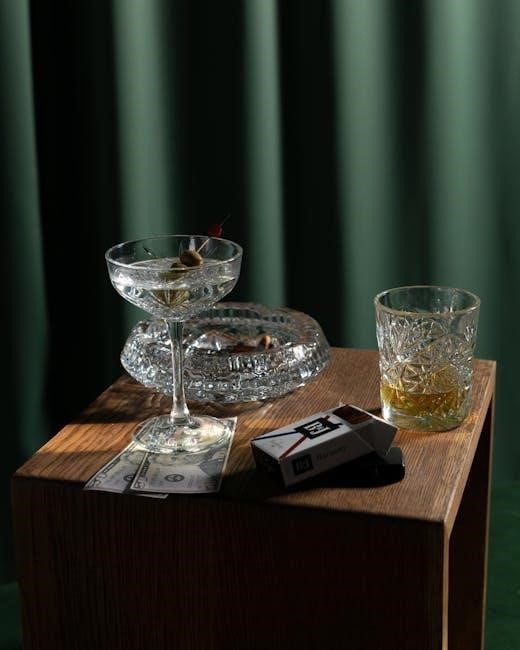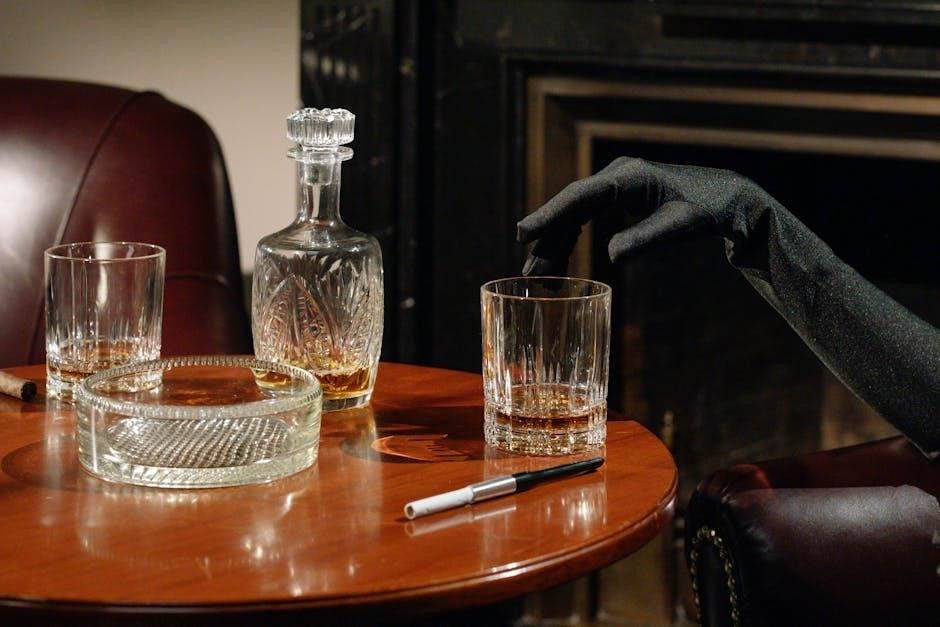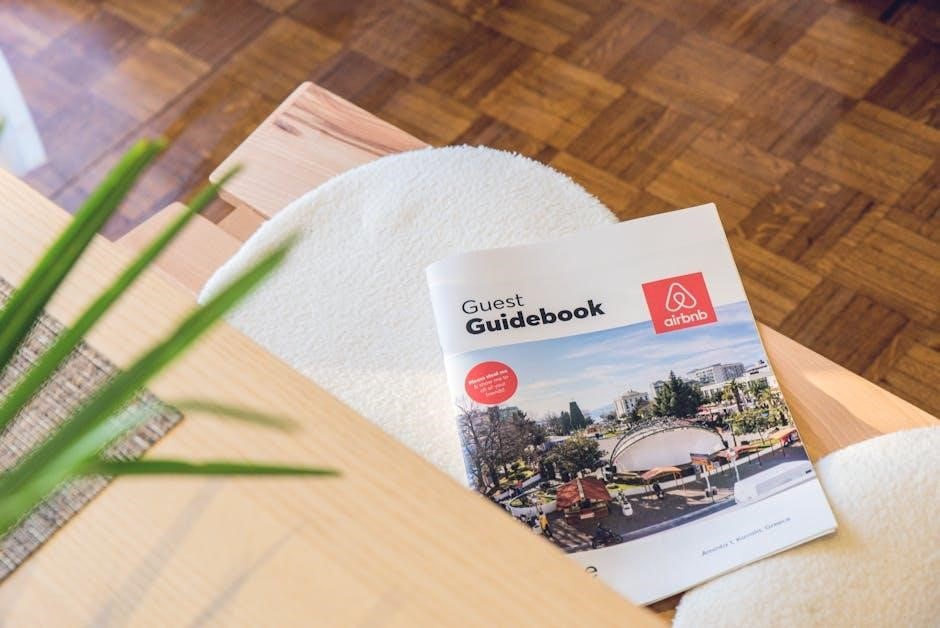
A cigar is a rolled bundle of dried and fermented tobacco leaves, offering a luxurious smoking experience․ Originating in ancient Mesoamerica, cigars have evolved into a global symbol of sophistication, enjoyed for their rich flavors, intricate craftsmanship, and the cultural heritage they embody․ Whether you’re a seasoned aficionado or a curious newcomer, this guide will navigate you through the world of cigars, exploring their history, types, and the art of enjoyment․
What is a Cigar?
A cigar is a tightly rolled bundle of dried and fermented tobacco leaves, typically cylinder-shaped and varying in size․ It consists of three main components: the filler (core tobacco), binder (holds filler together), and wrapper (outer layer)․ Unlike cigarettes, cigars are not machine-rolled but crafted with precision, often by hand․ They are enjoyed for their rich, complex flavors and aromas, with enthusiasts savoring the experience through slow, deliberate puffs․ A cigar is more than a smoke—it’s a celebration of craftsmanship, taste, and tradition․
A Brief History of Cigars
Cigars trace their origins to ancient Mesoamerica, where they were first smoked by the Maya and Aztecs as a symbol of wealth and ritual․ Christopher Columbus introduced tobacco to Europe in the 15th century, sparking widespread popularity; By the 19th century, cigars became a staple of luxury and culture, with Cuba emerging as a premier producer․ The Golden Age of cigars in the late 19th and early 20th centuries saw iconic brands rise, but political shifts, like the Cuban Revolution, reshaped the industry․ Today, cigars are enjoyed globally, blending tradition with modern craftsmanship․
Why People Enjoy Cigars
People enjoy cigars for their sophisticated experience, blending relaxation and refinement․ The slow, deliberate process of smoking a cigar offers a moment of calm, often savored during special occasions or with friends․ Many appreciate the rich, complex flavors and aromas, which vary based on tobacco origins and aging processes․ Cigars also represent a connection to history and culture, with enthusiasts valuing the craftsmanship behind each hand-rolled piece․ Whether for celebration, contemplation, or the joy of collecting, cigars provide a unique and indulgent experience․

Types of Cigars
Cigars come in diverse types, categorized by wrapper types, shapes, sizes, and strengths, offering a wide range of experiences for every smoker’s preference․
Wrapper Types: Maduro, Natural, and Connecticut
Cigars are categorized by their wrapper types, each offering unique flavors and appearances․ Maduro wrappers are dark, rich, and sweet, aged longer for deeper notes․ Natural wrappers are lighter, showcasing earthy and nutty undertones․ Connecticut wrappers, known for their light color, provide smooth, creamy profiles with subtle spice․ These distinct wrapper types cater to diverse preferences, allowing smokers to choose flavors that align with their taste, from bold to mild․ Each wrapper’s characteristics significantly influence the overall cigar experience, making them a cornerstone of cigar classification․
Cigar Shapes and Sizes
Cigars come in various shapes and sizes, each offering a unique smoking experience․ Common shapes include Robusto, Churchill, and Panatela, with lengths and ring gauges varying widely․ Robusto, a popular choice, typically measures 4-5 inches with a 50-ring gauge, providing a balanced smoke․ Churchill cigars are longer, around 7 inches, allowing for a slower burn and extended enjoyment․ Panatelas are slender and elegant, often favored for their nuanced flavor profiles․ The size and shape significantly impact burn time and flavor delivery, catering to different preferences and occasions․
Cigar Strengths: Mild, Medium, and Full Bodied
Cigars are categorized by strength, ranging from mild to full-bodied, each offering distinct flavor profiles․ Mild cigars are light and smooth, with notes of cream, nuts, and subtle spices, ideal for beginners․ Medium-bodied cigars strike a balance, blending earthy, woody, and slightly sweet flavors․ Full-bodied cigars are robust, delivering bold, complex flavors like leather, dark chocolate, and spices, appealing to experienced smokers․ The strength impacts the smoking experience, allowing enthusiasts to choose based on their preference for subtlety or intensity․

Understanding Cigar Components
A cigar consists of three main components: filler, binder, and wrapper tobaccos․ Each plays a crucial role in shape, flavor, and combustion, ensuring a premium smoking experience․
Filler Tobacco: The Core of the Cigar
Filler tobacco forms the bulk of a cigar and determines its strength and flavor profile․ It is made from a blend of leaves, often sourced from different regions, each contributing unique characteristics such as sweetness, spice, or earthiness․ The filler is carefully selected and aged to ensure a smooth, consistent burn․ The quality and composition of the filler directly impact the cigar’s overall taste and aroma, making it the foundation of the smoking experience․ Proper blending ensures a balanced and complex flavor profile․
Binder Tobacco: Holding It All Together
Binder tobacco encases the filler, ensuring the cigar’s structural integrity and smooth burn․ It is typically made from strong, elastic leaves that withstand rolling pressures․ The binder’s primary role is to hold the filler together while contributing to the cigar’s overall flavor profile subtly․ Its quality directly impacts the burn consistency and draws smoothly․ Often sourced from regions like Nicaragua or the Dominican Republic, binder tobacco is aged to enhance its resilience and flavor nuances, playing a crucial role in the cigar’s smoking experience․
Wrapper Tobacco: The Outer Layer
Wrapper tobacco is the outermost layer of a cigar, defining its appearance and contributing significantly to its flavor and aroma․ Grown in regions like Ecuador and Connecticut, wrapper leaves are meticulously selected for their texture, color, and oil content․ They come in various shades, from light Connecticut to dark Maduro, each offering unique taste profiles․ The wrapper is fermented longer than other tobaccos to enhance its complexity, ensuring a smooth, refined smoking experience․ Its quality and aesthetics play a pivotal role in a cigar’s appeal and overall character․

How to Choose the Right Cigar
Selecting the perfect cigar involves considering flavor preferences, size, strength, and pairing options․ Start with milder options if new, then explore bolder choices as you refine your palate․ Always pair with complementary drinks like whiskey or coffee for an enhanced experience․ Your experience level and aroma preferences will guide your ideal choice, ensuring a satisfying and enjoyable smoking experience tailored to your taste․
Determining Your Flavor Preferences
Determining your flavor preferences is the first step in choosing the right cigar․ Consider whether you enjoy mild, medium, or full-bodied flavors․ Mild cigars offer subtle notes of cream and nuts, while medium-bodied options provide balanced earthy and spicy hints․ Full-bodied cigars deliver robust, bold flavors with hints of leather and spice․ Experiment with different wrapper types and tobacco origins to identify what resonates with your palate․ Personal taste plays a significant role, so take your time to explore and refine your preferences for a truly satisfying experience․
Selecting the Right Size and Strength
Selecting the right size and strength ensures a personalized smoking experience․ Cigar sizes vary, with options like Robusto or Churchill, affecting smoking duration; Strength levels—mild, medium, or full-bodied—cater to different preferences․ Mild cigars are ideal for beginners, offering subtle flavors, while full-bodied options provide bold, complex notes․ Consider your tolerance and the time you have to enjoy the cigar․ Pairing size with strength helps balance flavor and smoking time, ensuring a satisfying experience tailored to your liking and expertise level․
Pairing Cigars with Drinks
Pairing cigars with the right beverages enhances the smoking experience․ Classic choices include whiskey, rum, or coffee, as they complement the cigar’s flavors․ For full-bodied cigars, try pairing with robust drinks like scotch or red wine, while mild cigars pair well with coffee or tea․ The key is to balance the drink’s strength with the cigar’s intensity․ Experimenting with different combinations allows you to discover your perfect match, elevating both the cigar and drink’s nuances for a refined and enjoyable experience․

The Art of Smoking a Cigar
Mastering the art of smoking a cigar involves savoring its rich flavors and nuances․ Proper techniques, such as cutting, lighting, and drawing, ensure a smooth, enjoyable experience for aficionados․

Preparing Your Cigar
Preparing your cigar is the first step to an enjoyable experience․ Begin by selecting a sharp cutter or punch to trim the cap, ensuring a clean draw․ Inspect the cigar for soft spots or lumps, as these can affect burning․ Store cigars in a humidor at 68-72% humidity to maintain freshness․ Before lighting, allow the cigar to rest for a few minutes to balance the internal moisture․ Proper preparation enhances flavor and ensures a smooth, even burn, making the experience truly satisfying for any cigar enthusiast․
Lighting Techniques
Proper lighting is essential for a satisfying cigar experience․ Use a torch lighter or traditional matches to ensure an even burn․ Hold the flame to the foot of the cigar, allowing the heat to draw through without directly touching the flame to the tobacco․ Rotate the cigar to evenly light the entire circumference․ Once lit, take a few puffs to ensure the burn is consistent․ Proper lighting enhances the flavor and aroma, making the experience more enjoyable․ Avoid using quick lighters, as they can alter the cigar’s natural taste․
The Proper Way to Smoke a Cigar
Smoking a cigar is an art that requires patience and finesse․ Hold the cigar between your thumb and index finger, resting it gently in your hand․ Bring it to your mouth, puffing slowly to draw the smoke without inhaling․ Rotate the cigar periodically to ensure an even burn․ Avoid puffing too frequently, as this can cause overheating and bitterness․ Take your time, savoring the flavors and aromas, as a quality cigar can last 30 minutes to several hours․ Proper etiquette involves not rushing the experience and enjoying it mindfully․

Cigar Accessories
Cigar accessories enhance the smoking experience, including cutters, lighters, and humidors․ These tools preserve cigar quality, ensure proper preparation, and maintain optimal storage conditions for longevity;
Essential Tools: Cutters, Lighters, and Humidors
Cutters, lighters, and humidors are indispensable for cigar enthusiasts․ Cutters trim the cigar cap precisely, ensuring an even draw, while lighters provide a consistent flame for ignition․ Humidors maintain optimal humidity, preserving cigar quality and aroma․ These tools enhance the smoking experience, with cutters available in guillotine or punch styles and lighters often featuring torch flames for efficient lighting․ A well-maintained humidor, typically cedar-lined, ensures cigars age gracefully․ Investing in these accessories elevates the ritual of cigar smoking, combining functionality with sophistication․
Maintaining Your Humidor
Maintaining a humidor ensures optimal cigar storage and preservation․ Keep humidity levels between 65-70% using a reliable humidifier․ Regularly check the hygrometer to monitor conditions․ Season a new humidor with distilled water before use․ Avoid direct sunlight and extreme temperatures․ Store cigars away from strong odors, as they can absorb smells․ Gently clean the interior with a damp cloth periodically․ Proper maintenance prolongs the life of your cigars, preserving their flavor and aroma․ A well cared-for humidor is essential for any serious cigar enthusiast․

Cigar Etiquette and Culture
Cigar culture embodies respect for tradition, craftsmanship, and communal enjoyment․ It’s a ceremonial experience where enthusiasts gather to savor flavors and share stories, fostering a sense of camaraderie and appreciation․

Smoking in Social Settings
Smoking cigars in social settings requires mindfulness and etiquette․ Always ask permission before lighting up, especially indoors․ Be considerate of non-smokers and ensure the environment is appropriate․ Properly prepare your cigar, avoiding strong odors or disturbances․ Dispose of ashes and butts responsibly․ Engage respectfully, offering cigars to others if shared․ This cultural exchange fosters camaraderie and shared enjoyment, reflecting the tradition and sophistication cigars embody․
Cigar Pairing Events
Cigar pairing events are gatherings where enthusiasts explore the art of combining cigars with complementary flavors․ These events often feature curated selections of cigars paired with fine wines, whiskies, or craft beers to enhance the smoking experience․ Attendees learn how different tobaccos and drinks interact, creating a harmonious balance of flavors․ Such events foster a sense of community, offering a space to share knowledge, savor moments, and celebrate the nuances of cigar culture․ They are ideal for both novices and connoisseurs seeking to expand their palates․